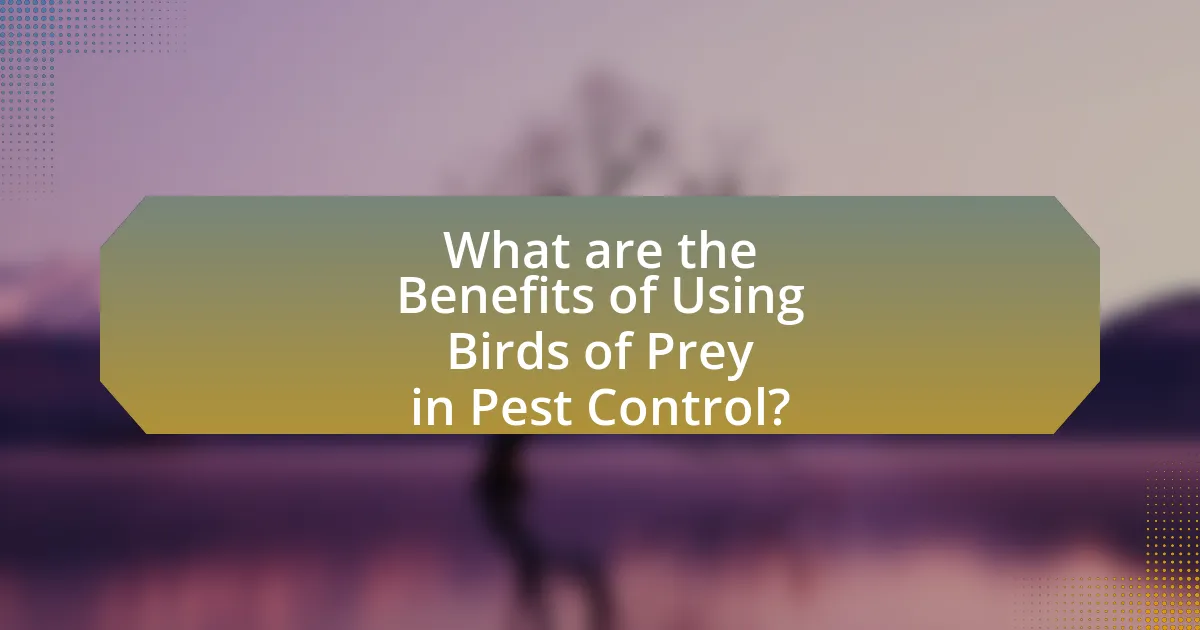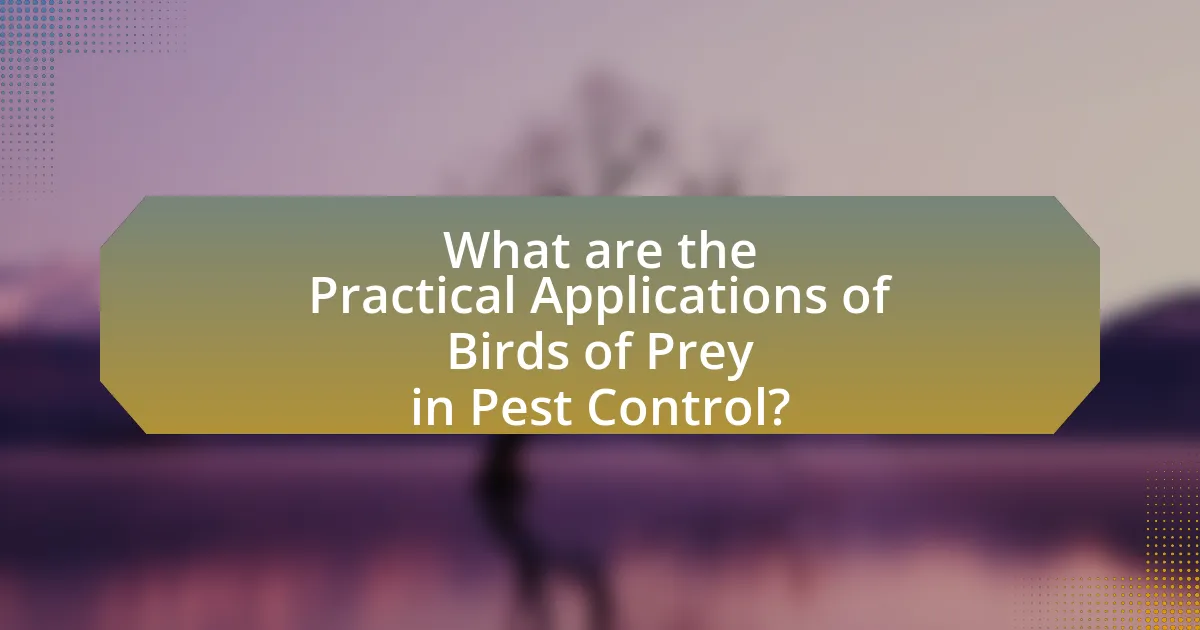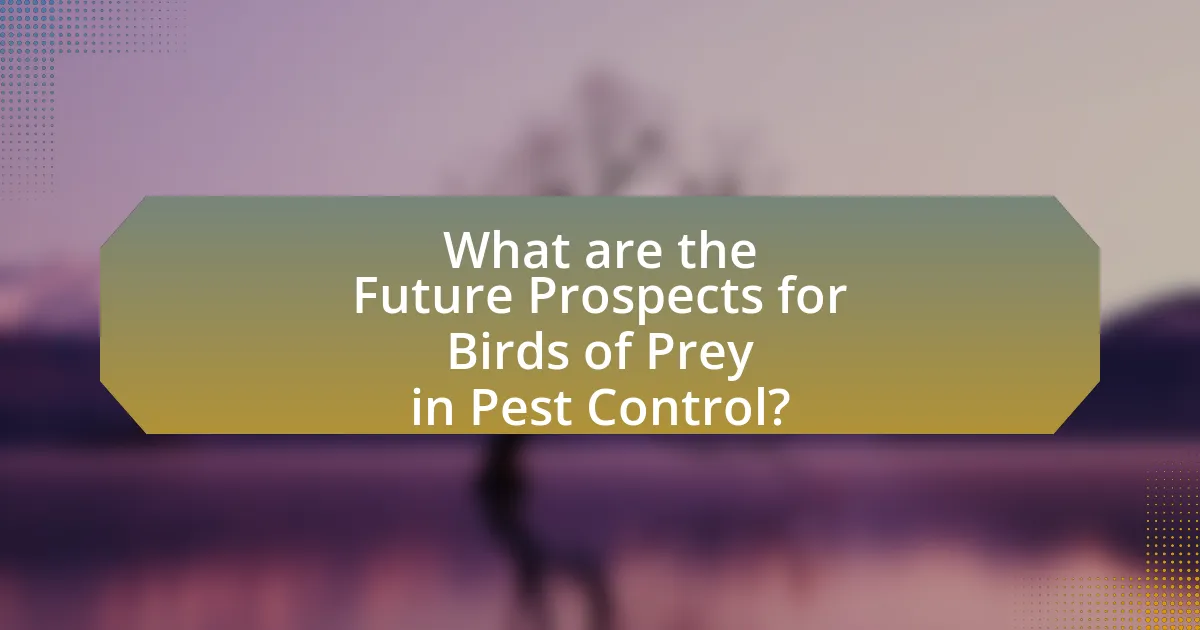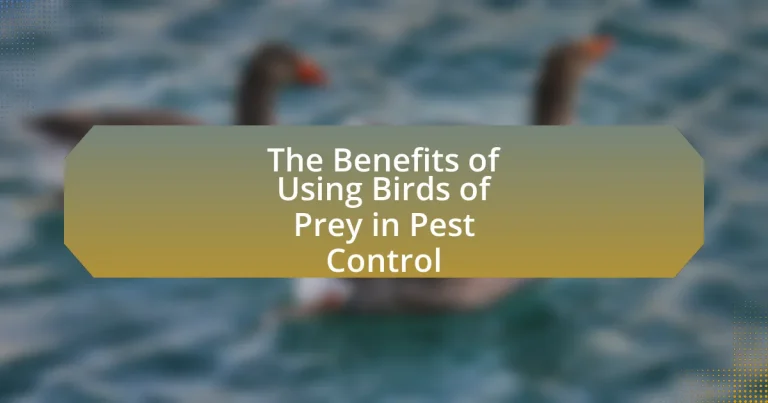The article focuses on the benefits of using birds of prey, such as hawks and owls, in pest control. It highlights their effectiveness in naturally managing pest populations, reducing reliance on chemical pesticides, and promoting ecological balance. Key points include the significant reduction of pests like rodents and insects through natural predation, the importance of considering ecological impacts in pest management, and practical applications for farmers and landowners to implement raptors in agricultural settings. Additionally, the article discusses the challenges and legal considerations associated with using birds of prey, as well as future prospects and technological innovations that enhance their role in sustainable pest control.
What are the Benefits of Using Birds of Prey in Pest Control?

Using birds of prey in pest control offers several benefits, including effective natural pest management, reduced reliance on chemical pesticides, and ecological balance. Birds of prey, such as hawks and owls, are skilled hunters that can significantly reduce populations of rodents and other pests, leading to lower crop damage and improved agricultural yields. Studies have shown that integrating raptors into pest management strategies can decrease pest populations by up to 90% in some cases, demonstrating their efficiency. Additionally, utilizing these birds promotes biodiversity and supports the ecosystem, as they play a crucial role in maintaining the food chain.
How do birds of prey contribute to effective pest management?
Birds of prey contribute to effective pest management by naturally controlling populations of rodents and insects that can damage crops and spread diseases. These raptors, such as hawks and owls, are skilled hunters that can significantly reduce the numbers of these pests, thereby minimizing the need for chemical pesticides. Research indicates that a single pair of breeding owls can consume over 1,000 rodents in a single breeding season, demonstrating their impact on pest populations. This natural predation not only helps maintain ecological balance but also promotes sustainable agricultural practices by reducing reliance on synthetic pest control methods.
What types of pests can birds of prey control?
Birds of prey can control various types of pests, including rodents, insects, and small mammals. Specifically, species such as hawks and owls are effective in reducing populations of common agricultural pests like voles, mice, and even insects such as grasshoppers. Research indicates that the presence of these raptors can lead to a significant decrease in pest populations, thereby benefiting agricultural practices and reducing the need for chemical pesticides. For instance, studies have shown that the use of raptors in integrated pest management can lower rodent populations by up to 70%, demonstrating their effectiveness as natural pest controllers.
How do birds of prey compare to traditional pest control methods?
Birds of prey offer a more sustainable and environmentally friendly alternative to traditional pest control methods, which often rely on chemical pesticides. Unlike chemical methods that can harm non-target species and lead to pesticide resistance, birds of prey naturally regulate pest populations through predation, maintaining ecological balance. Studies have shown that using raptors can reduce rodent populations by up to 70% in agricultural settings, demonstrating their effectiveness. Additionally, birds of prey do not pose the same risks to human health and the environment as chemical pesticides, making them a safer choice for pest management.
Why is it important to consider ecological impacts in pest control?
Considering ecological impacts in pest control is crucial because it ensures the sustainability of ecosystems and minimizes harm to non-target species. Effective pest control methods that account for ecological consequences can prevent the disruption of food webs and the loss of biodiversity. For instance, the use of chemical pesticides can lead to the decline of beneficial insects and other wildlife, which are essential for pollination and natural pest regulation. Research indicates that integrating ecological considerations into pest management strategies can enhance the resilience of agricultural systems while promoting environmental health.
What role do birds of prey play in maintaining ecological balance?
Birds of prey play a crucial role in maintaining ecological balance by regulating populations of small mammals and other prey species. This predation helps prevent overpopulation, which can lead to habitat degradation and resource depletion. For instance, studies have shown that raptors can significantly reduce populations of rodents, which, if left unchecked, can cause crop damage and spread diseases. By controlling these populations, birds of prey contribute to a healthier ecosystem, promoting biodiversity and stability within their habitats.
How does using birds of prey reduce chemical pesticide use?
Using birds of prey reduces chemical pesticide use by providing a natural method of pest control that targets rodent and insect populations. These raptors, such as hawks and owls, effectively hunt and manage pest species, thereby decreasing the reliance on synthetic pesticides. Research indicates that integrating birds of prey into agricultural practices can lead to a significant reduction in pest populations, which in turn lowers the need for chemical interventions. For instance, a study published in the journal “Biological Control” found that farms utilizing raptors experienced up to a 50% decrease in pest-related damage, demonstrating the efficacy of this natural approach.
What are the Practical Applications of Birds of Prey in Pest Control?

Birds of prey are effectively utilized in pest control by naturally managing populations of rodents and insects. Their hunting behavior reduces the need for chemical pesticides, promoting an eco-friendly approach to pest management. For instance, studies have shown that using raptors can decrease rodent populations by up to 70% in agricultural settings, leading to improved crop yields and reduced economic losses. Additionally, the presence of birds of prey can deter other pests, creating a balanced ecosystem that supports biodiversity while minimizing agricultural damage.
How can farmers and landowners implement birds of prey for pest control?
Farmers and landowners can implement birds of prey for pest control by creating suitable habitats and nesting sites to attract these raptors. Establishing perches, such as poles or platforms, allows birds of prey to survey the land for rodents and other pests. Additionally, maintaining a diverse ecosystem that supports prey populations, like small mammals and insects, enhances the effectiveness of birds of prey in controlling pest numbers. Research indicates that using raptors can reduce rodent populations by up to 50%, demonstrating their effectiveness as a natural pest control method.
What are the best practices for attracting birds of prey to agricultural areas?
To attract birds of prey to agricultural areas, landowners should implement habitat enhancement practices such as creating perches, providing nesting sites, and maintaining open spaces for hunting. These practices encourage raptors to establish territories and hunt for pests, thereby aiding in pest control. Research indicates that the presence of artificial perches can increase raptor sightings by up to 50%, demonstrating their effectiveness in attracting these birds. Additionally, preserving natural vegetation and providing food sources, such as small mammals, can further enhance the habitat’s appeal to birds of prey.
How can habitat management enhance the effectiveness of birds of prey?
Habitat management can enhance the effectiveness of birds of prey by creating optimal hunting conditions and ensuring the availability of prey species. By maintaining diverse habitats, such as grasslands, wetlands, and forests, habitat management supports a balanced ecosystem that provides ample food sources for birds of prey. Research indicates that areas with varied vegetation and open spaces allow these birds to hunt more efficiently, as they can spot and capture prey more easily. For instance, studies have shown that raptor populations thrive in landscapes where habitat management practices, like controlled burns and selective logging, are implemented, leading to increased prey abundance and improved hunting success rates.
What are the challenges associated with using birds of prey in pest control?
The challenges associated with using birds of prey in pest control include the need for extensive training, potential ecological imbalances, and the risk of non-target species being affected. Training birds of prey requires skilled handlers and significant time investment to ensure they can effectively hunt specific pests without causing harm to other wildlife. Additionally, introducing birds of prey into an ecosystem can disrupt local food chains, as these predators may target not only pests but also beneficial species. Furthermore, there is a risk that birds of prey may inadvertently capture non-target animals, leading to unintended consequences for biodiversity.
What legal considerations must be taken into account?
Legal considerations in using birds of prey for pest control include compliance with wildlife protection laws, obtaining necessary permits, and ensuring humane treatment of the animals. Wildlife protection laws, such as the Migratory Bird Treaty Act in the United States, prohibit the capture, killing, or possession of certain bird species without a permit. Additionally, operators must secure permits from relevant authorities to use birds of prey for pest control, which may involve demonstrating the necessity and safety of the practice. Ensuring humane treatment is also critical, as regulations may dictate the conditions under which birds are kept and trained, emphasizing the need for proper care and ethical practices.
How can landowners address potential conflicts with other wildlife?
Landowners can address potential conflicts with other wildlife by implementing integrated pest management strategies that include the use of birds of prey. This approach not only helps control pest populations but also minimizes negative interactions with other wildlife species. Research indicates that using raptors for pest control can reduce reliance on chemical pesticides, which can harm non-target wildlife and disrupt local ecosystems. For instance, a study published in the Journal of Wildlife Management found that the presence of trained hawks significantly decreased rodent populations without adversely affecting other wildlife, demonstrating an effective balance between pest control and wildlife conservation.
What are the Future Prospects for Birds of Prey in Pest Control?

The future prospects for birds of prey in pest control are promising due to their effectiveness in managing rodent and insect populations. Studies have shown that raptors can significantly reduce pest numbers, leading to decreased reliance on chemical pesticides. For instance, research conducted by the University of California demonstrated that the presence of hawks and owls in agricultural areas resulted in a 50% reduction in rodent populations, which in turn benefited crop yields. Additionally, as organic farming practices gain popularity, the use of birds of prey aligns with sustainable pest management strategies, enhancing biodiversity and ecosystem health.
How is technology influencing the use of birds of prey in pest management?
Technology is significantly enhancing the use of birds of prey in pest management by providing tools for tracking, training, and monitoring their effectiveness. For instance, GPS tracking devices allow falconers to monitor the movements and hunting patterns of birds, improving their deployment strategies in agricultural settings. Additionally, advancements in drone technology enable the assessment of pest populations and habitat conditions, allowing for more targeted use of raptors. Research indicates that integrating these technologies can increase the efficiency of pest control efforts, as demonstrated in studies showing a reduction in rodent populations by up to 90% when birds of prey are utilized alongside technological tools.
What innovations are being developed to support birds of prey in pest control?
Innovations being developed to support birds of prey in pest control include the use of GPS tracking technology and artificial intelligence for monitoring and managing their hunting patterns. GPS devices allow researchers to track the movements and behaviors of birds of prey, providing data that can optimize their deployment in pest control efforts. Additionally, AI algorithms analyze this data to predict pest populations and identify the most effective times and locations for birds to hunt. These advancements enhance the efficiency of birds of prey in controlling pest populations, thereby promoting sustainable agricultural practices.
How can research improve the effectiveness of birds of prey in pest control?
Research can improve the effectiveness of birds of prey in pest control by identifying optimal species for specific pest populations and enhancing training methods for these birds. Studies have shown that certain raptor species, such as peregrine falcons and red-tailed hawks, are more effective at controlling particular pests due to their hunting behaviors and prey preferences. For instance, research published in the Journal of Wildlife Management indicates that using native raptors can lead to a 50% reduction in rodent populations in agricultural settings. Additionally, advancements in training techniques, such as positive reinforcement and habitat acclimatization, can increase hunting success rates. By focusing on these areas, research can provide actionable insights that enhance the role of birds of prey in integrated pest management strategies.
What practical tips can be applied for successful integration of birds of prey in pest control?
To successfully integrate birds of prey in pest control, it is essential to assess the specific pest problem and select the appropriate species of raptor that naturally preys on those pests. For instance, using hawks can effectively control small mammal populations, while owls are more suited for rodent control due to their nocturnal hunting habits.
Additionally, creating a suitable habitat for the birds is crucial; this includes providing perches, nesting sites, and ensuring a sustainable food source. Implementing a training program for the birds can enhance their hunting efficiency and adaptability to the environment.
Monitoring the effectiveness of the birds in controlling pest populations is also important, as it allows for adjustments in strategy if necessary. Research indicates that integrating birds of prey can reduce pest populations significantly, with studies showing a 50-90% reduction in certain pest species when raptors are utilized effectively.
How can landowners monitor the effectiveness of birds of prey in their pest control efforts?
Landowners can monitor the effectiveness of birds of prey in their pest control efforts by tracking pest populations and observing predation rates. By conducting regular surveys of pest species, such as rodents or insects, landowners can establish baseline population levels before introducing birds of prey. Following the introduction, landowners should document changes in pest populations over time, noting any significant declines that correlate with the presence of the birds. Additionally, using camera traps or direct observation can help quantify the number of successful hunts by the birds, providing further evidence of their impact on pest control. Studies have shown that the presence of raptors can lead to a reduction in rodent populations by up to 70%, demonstrating their effectiveness in managing pests.
What resources are available for those interested in using birds of prey for pest management?
Resources available for those interested in using birds of prey for pest management include organizations such as the North American Falconers Association and the International Association of Falconry and Conservation of Birds of Prey, which provide training, guidelines, and networking opportunities. Additionally, academic research, such as studies published in the Journal of Raptor Research, offers insights into effective practices and case studies demonstrating successful pest management through raptor use. These resources collectively support individuals and businesses in implementing birds of prey as a sustainable pest control method.


